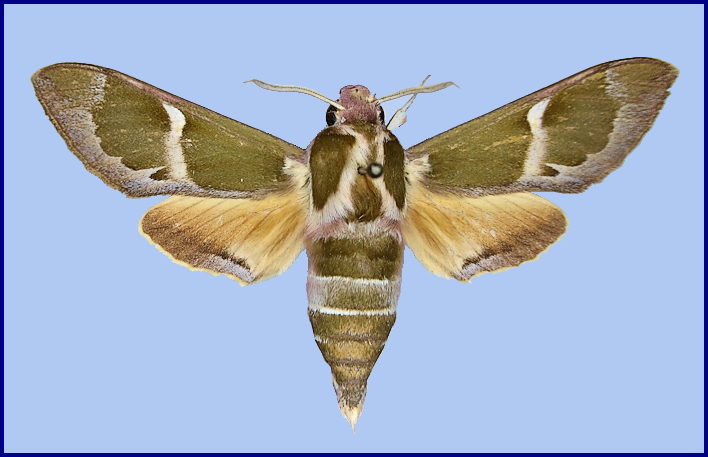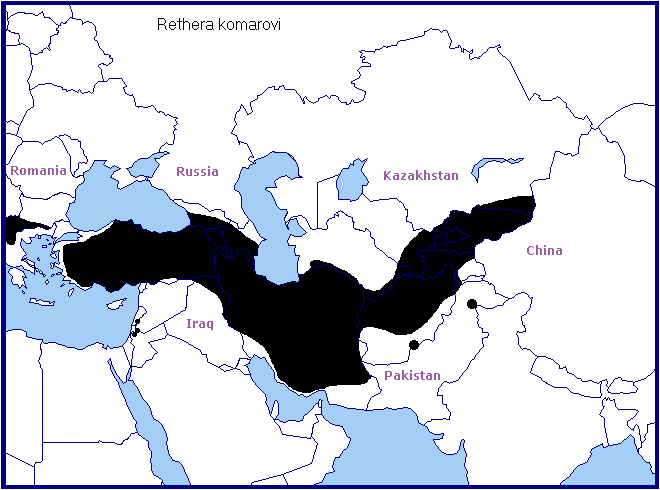(Taxonomic note. The various subspecies and forms of Rethera komarovi appear to have developed in several isolated refugia during the last (Pleistocene) ice-age. They have since re-established contact and appear to be merging in a manner similar to Deilephila porcellus (Linnaeus, 1758.). The partitioning of the races in this site is based on morphological features combined with DNA barcoding, although the differences between some of the races is rather small.
[Further details on this species, as well as photos of all stages, can be found on Lepiforum.]
UK: Madder Hawkmoth; Komarov's Sphinx, RUS: Komarova Brazhnik, CZ: Lišaj komarovi, FIN: Venäjänkiitäjä.
Deilephila komarovi Christoph, 1885, in Romanoff, 1885, Mémoires sur les Lépidoptères 2: 169.Type locality: Askhabad, near Germob [Ashkhabad, Turkmenistan].
Holarctic; western Palaearctic region. Pleistocene refuge: Monocentric -- unclear, probably the western half of the Iranian refuge.

Wingspan: 55--65mm. Similar to subsp. rjabovi O. Bang-Haas, 1935 and subsp. stipularis (Swinhoe, 1885), but closer to the latter.
Exhibits little variation except for the intensity of 'tint' colours, which range, ventrally, from pale orange to deep pink. Newly-emerged examples often have a magnificent rose sheen. However, due to the fact that the dorsal green coloration fades in strong sunlight, those collected from drier regions tend to be paler than examples from more verdant areas. The same applies when killing agents such as diethyl ether and ethyl acetate are used.
Frequents 'vegetation islands' on sparsely vegetated cliffs and rocky slopes which are cold in winter and become parched in summer.
Univoltine; mid-April to the second week of June, depending on location and season.
OVUM: Unknown, but probably identical to that of subsp. rjabovi.
LARVA: Unknown, but probably identical to that of subsp. rjabovi.
Hostplants. Unknown, but probably Rubia and Galium spp. The larva from the Kopet-Dagh, Turkmenistan, described by Buresch & Tuleschkow (1931) as feeding on a species of Euphorbia, matches that of Hyles euphorbiae conspicua (Rothschild & Jordan, 1903) and was not that of Rethera komarovi.
PUPA: Unknown, but probably identical to that of subsp. rjabovi.
None recorded.
The Kopet-Dagh Mountains of northeastern Iran and southwestern Turkmenistan (Christoph, 1885).
Extra-limital range. None.

South-east Europe (northern Greece, Albania, the Republic of Macedonia, western Bulgaria) and western/central Turkey as subsp. drilon (Rebel & Zerny, 1931). Eastern Turkey, the mountains straddling Jordan, Syria and Lebanon, the Republic of Georgia, Armenia, Azerbaijan, Iraqi Kurdistan (Wiltshire, 1957), and from northern Iran south along the Zagros Mountains (Barou, 1967; Ghassemi, Alemansoor & Alehossein, 2010) to the rest of central, southern and eastern Iran (and maybe also western Afghanistan (Ebert, 1969)) as subsp. rjabovi O. Bang-Haas, 1935. Central and eastern Afghanistan (Ebert, 1969), Balochistan and the Hindukush area of western/northern Pakistan (leg. Z. Varga & G. Ronkay, ex coll. György Fábián, coll. Sphingidae museum of Czech Rep.), southern Uzbekistan (Western Gissar Mountains), Tajikistan (Derzhavets, 1984), Kyrgyzstan and southern and eastern Kazakhstan (Eitschberger & Lukhtanov, 1996) as subsp. stipularis (Swinhoe, 1885).
 Return to species list
Return to species list